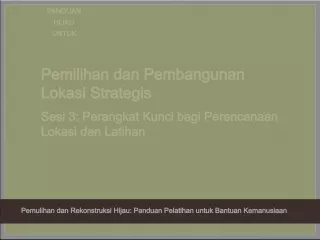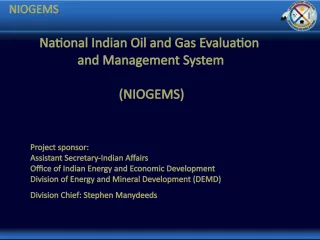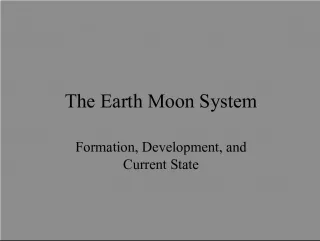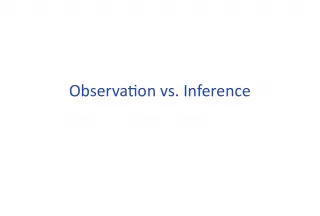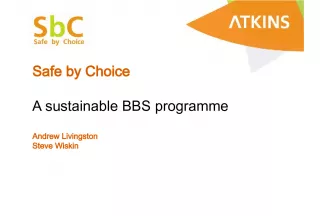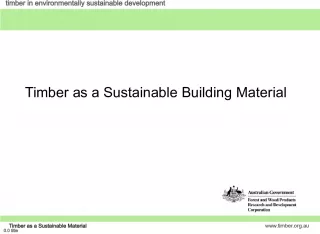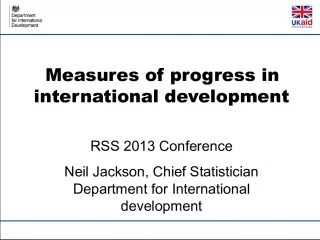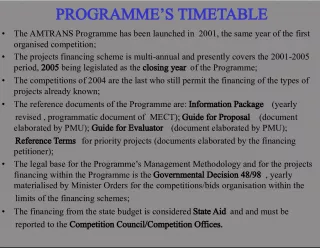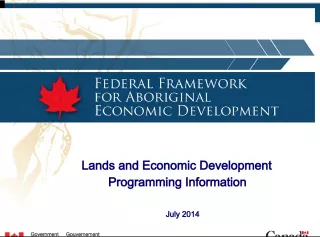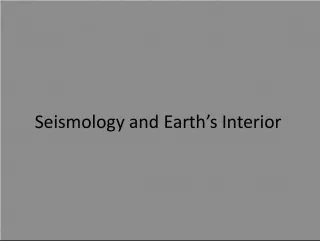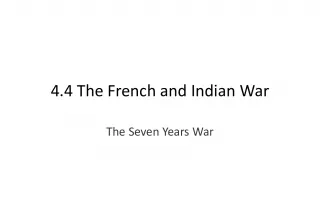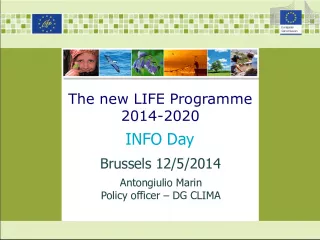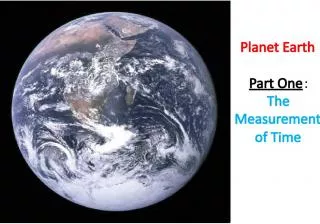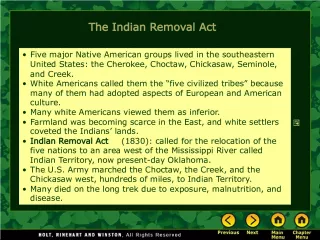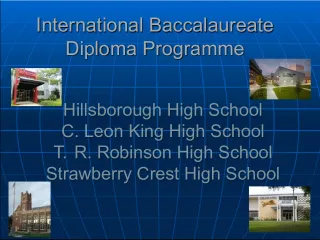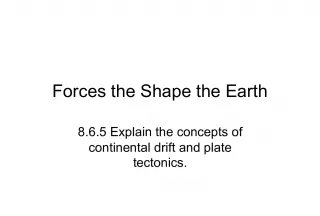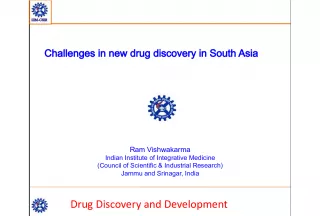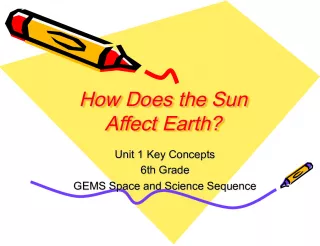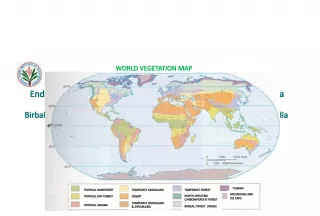Indian Earth Observation Programme: Enabling Sustainable Development
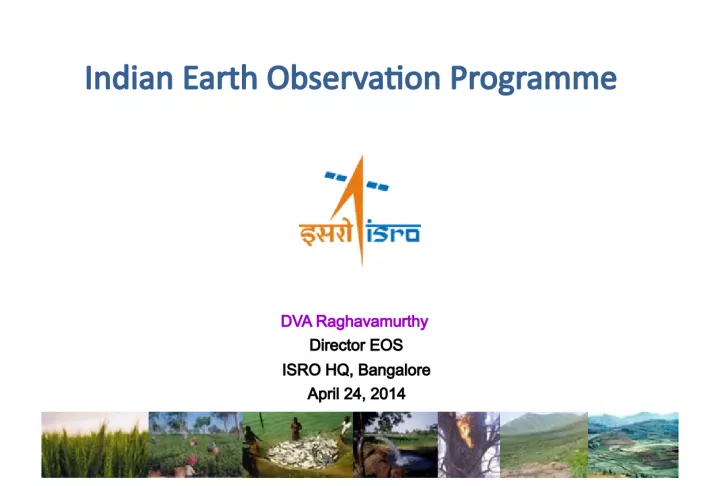

This article discusses the Indian Earth Observation Programme and its unique constellation of satellites, strong ground mechanisms, and diverse applications in natural resources, infrastructure, livelihoods, and disaster management. It highlights the program's institutional framework, ground support, and enabling techniques, along with its efforts to reach communities and address the nation's developmental priorities.
- Uploaded on | 8 Views
-
 lawrence
lawrence
About Indian Earth Observation Programme: Enabling Sustainable Development
PowerPoint presentation about 'Indian Earth Observation Programme: Enabling Sustainable Development'. This presentation describes the topic on This article discusses the Indian Earth Observation Programme and its unique constellation of satellites, strong ground mechanisms, and diverse applications in natural resources, infrastructure, livelihoods, and disaster management. It highlights the program's institutional framework, ground support, and enabling techniques, along with its efforts to reach communities and address the nation's developmental priorities.. The key topics included in this slideshow are Earth observation, Indian space program, natural resources, disaster management, livelihoods,. Download this presentation absolutely free.
Presentation Transcript
1. Indian Earth Observation Programme DVA Raghavamurthy Director EOS ISRO HQ, Bangalore April 24, 2014
2. Indian EO Programme: The Uniqueness Vibrant Space Segment: Constellation of Satellites Resourcesat, Cartosat, Oceansat Strong Ground Mechanisms Institutional Framework: NNRMS Ground support: Enabling techniques Diversity of Applications Natural Resources: Land & Water Infrastructure : Physical & Social Livelihood : PFZ, Bharat Nirman Disaster Management Support Reaching to Community Addressing Nation s developmental priorities
3. Thematic Satellites Series Operational Indian Remote Sensing Satellites National missions on various themes GIS databases for decision support Integrated mission for sustainable development IRS utilisation prorgramme Joint experiments programme Bhaskara utilisation - first user programme Landsat data utilisation - experimental applications Landsat station 1979 Coconut wilt - helicopter images THE EVOLUTION 1991 1988 1995 1996 1997 1999 2001 2003 2005 2007 2008 2009 2010 2011 2012 2013 IRS-1A : LISS-1 & 2 IRS-1C : LISS-3, PAN & WiFS IRS-P3 : WiFS, MOS, X-Ray OCEANSAT-1 : OCM & MSMR TES : PAN IRS-1A : LISS-1 & 2 IRS-1D : LISS-3, PAN & WiFS RESOURCESAT-1 : LISS 3; LISS 4; AWiFS CARTOSAT-2: PAN CARTOSAT-1: PAN stereo RISAT-2 : X-SAR RESOURCESAT- 2: LISS 3, LISS 4, AWiFS CARTOSAT-2A : PAN CARTOSAT-2B : PAN RISAT-1 : C-SAR OCEANSAT-2: OCM, SCAT, ROSA MEGHA- TROPIQUES: SAPHIR, SCARAB & MADRAS 25 Years since IRS-1A 1994 IRS-P2: LISS- 2 IMS-1: Mx, HySI SARAL INSAT-3D
4. 2003 RESOURCESAT-1 LISS 3; LISS 4; AWiFS 2007 CARTOSAT-2 PAN 2005 CARTOSAT-1 Stereo PAN, F/A 2002 KALPANA-1 VHRR 2003 INSAT- 3A VHRR, CCD Land & Water Cartographic Ocean & Atmosphere 2009 OCEANSAT-2 OCM , SCAT, ROSA 2011 RESOURCESAT-2 LISS 3; LISS 4; AWiFS 2011 MEGHA-TROPIQUES MADRAS, SAPHIR, SCaRaB 2012 RISAT-1 C-SAR Indian Earth Observation (in-orbit satellites) 2013 SARAL ALTIKA, ARGOS 2013 INSAT-3D IMAGER, SOUNDER (3 satellites) (2 satellites) (6 satellites)
5. Resourcesat-1 / 2 (2003, 2011) Land and Water Resources applications Natural Resources Mapping & Monitoring AWiFS LISS-III LISS-IV LISS-4 Mx : 5.8m Resolution and 70 km swath LISS-3 : 23.5m Resolution and 141 km Swath AWiFS : 56m Resolution and 740 km Swath Repetitivity: 5 days (AWiFS) to 24 days (LISS 3) & Revisit : 5 days (LISS 4) with tilting 26 deg tilt
6. Cartosat-2 Swath (km) : 10 SNR : 18 0 IGFOV (m) : 0 .8 SWR (%) : 1 0 Cartosat-1 and 2 (2005, 2007) Cartosat-1 2.5 m resolution, 30 km Swath Stereo mission; +26 / -5 forward/ Aft view Revisit : 5 days Along Track Stereo viewing - first of its kind in the world Cartosat-2 Data Products Handling of unique imaging modes paint brush multi-view in step and stare spot scenes Large scale mapping and Cartographic applications
7. Oceansat-2 A global mission, providing continuity of ocean colour data and wind vector in addition characterization of lower atmosphere and ionosphere from ROSA payload. Global data acquisition of Ocean colour High Resolution Data - NRSC and INCOIS 1 km resolution global products through NRSC Website Global Chlorophyll, Aerosol Optical Depth through NRSC Website 3531 OCM data downloaded from NRSC Website Scatterometer Wind Products Reception Station at Svalbard Real time transfer and processing Uploading to Web within 3 hrs through EUMETCAST 1.72 Lakhs data downloaded from NRSC Website Data Dissemination Mechanism Established Ground station at INCOIS Ground station at Bharti, Antarctica is being commissioned. EUMETCAST, NRSC Website for data and products
8. 100 km (UNQUALIFIED) FRS1/FRS2 MODE HRS MODE 400 km (QUALIFIED) 200 km 608 km 100 km (UNQUALIFIED ) CRS MODE MRS MODE o Stripmap FRS-1 / FRS-2 (Range Doppler/ Chirp Scaling) o ScanSAR MRS & CRS (Range Doppler/Specan) o Spotlight (modified sub-aperture) modes. Space borne SAR in C-band at 5.35 GHz Single/ Dual / Quad Polarisation imaging with 3 - 50 m Resolution & 10 - 240 km Swath Radar Imaging Satellite (RISAT-1 )
9. Altika/SARAL mission belongs to the global altimetry system for the precise and accurate observations of ocean topography, circulation and sea surface monitoring SARAL: Satellite with Argos and Altimeter Mission: Sun-synchronous, polar orbiting satellite Inclination: 98.38 Deg. Altitude: ~800 km Repeat cycle: 35 days Altika Payload: Ka-band (35.75 GHz, BW 500 MHz) radar altimeter Dual-frequency microwave radiometer (23.8 & 37 GHz) DORIS Laser Retro-reflector Array ISRO & CNES Collaboration SARAL/AltiKA SSHA observation overpass over Indian Ocean on Feb 28, 2013 and SLA from POM model at 0.5 degree resolution.
10. Future Satellites
11. o Panchromatic camera: 0.65 m o Multispectral: 2 m o No. of Bands: 4 o Swath : 10 km o Radiometric Resolution: 11 bit o Steering up to 26/45 o Event Monitoring Cameras: 2 Nos. EVM1: Res:0.5m Area: 1km x 1km; EVM2: Res:0.4m Area: 0.3x 0.2km o Altitude: 500 km o Solid State Recorder: 600 Gb o Local time: 0930 hrs o Revisit : 5 days o TDI Technology o Operational life: 5 Years CARTOSAT-2E Major Objectives To provide continuity of on-going data services of CARTOSAT-2 To design and develop a highly agile and advanced satellite with high spatial resolution both in panchromatic and multi- spectral bands To meet the increasing user demands for cartographic and cadastral level applications with improved revisit capability in tandem with Cartosat-2 missions.
12. o Panchromatic camera; 0.25 m o Multispectral (4 Bands): 1 m o Hyperspectral (200 Bands): 12 m o Swath : 16 km, 5 km (HySI) o Radiometric Resolution: 11 bit o Steering up to 26 (45 Possible) o Altitude: 450 km o Solid State Recorder: 2 Tb o Local time: 1030 hrs o Revisit : 5 days o TDI Technology o X and Ka Band Transmission o Operational life: 5 Years CARTOSAT-3 Major Objectives To design and develop an agile advanced satellite to obtain imagery with a very high spatial resolution of 0.25m Ground Sampling Distance (GSD) in panchromatic, 1m GSD in 4 band multi spectral; and selectable 12m GSD HySI with 50 VNIR bands or 12m GSD HySI with 150 SWIR bands with an operational life of 5 years. To meet the increasing user demands for very high resolution Panchromatic, Multispectral and Hyperspectral imagery.
13. GEO IMAGING SATELLITE (GISAT-1) High resolution multi-spectral VNIR (HRMX-VNIR): 50m Resolution Hyper spectral VNIR: 320m Resolution Hyper spectral SWIR (HyS-SWIR): 192m resolution High resolution Multi-spectral (HRMX-TIR): 1.5km Resolution Geostationary orbit of 36,000 km Every 30 minutes observation over India LAUNCH: 2016-17 LAUNCH: 2016-17
14. RESOURCESAT-2A SENSORS SPECTRA L BANDS Ground Resolution (meters) Swath (km) Radiometric Resolution (bits) Repetivity (days) LISS-III B2 B3 B4 B5 23.5 141 10 24 LISS-IV Mono B2 or B3 or B4 5.8 70 10 24 LISS-IV MX B2 B3 B4 5.8 23.5 or 70 10 24 AWiFS B2 B3 B4 B5 56 740 12 5 LAUNCH: 2015-16 LAUNCH: 2015-16 Major Objectives To provide continuity of on-going services of Resourecesat-2 and ensure in-orbit redundancy of the satellite Increased frequency of observations in tandem with Resourecesat-2 during overlap period To explore newer application areas in Land and Water Resources monitoring & management
15. OCEANSAT-3 is a global mission and is configured to cover global oceans and provide continuity of ocean colour data with global wind vector and characterization of lower atmosphere and ionosphere. OCEANSAT-3 Mission Payloads: An 13-band Ocean Colour Monitor ( OCM ) in VNIR (400-1010 nm range) with 360 m spatial resolution and 1400 km swath for ocean Colour monitoring 2-band Long Wave Infra Red ( LWIR ) around 11 and 12 m for Sea Surface Temperature (thermal channels) at 1080 m resolution. A Ku-Band Pencil beam SCATTEROMETER with a ground resolution of 50 km x 50 km for Continuity of wind vector data for cyclone forecasting and numerical weather modelling Objectives: Continuity of ocean colour data with improvements to continue and enhance operational services like potential fishery zone and primary productivity. To enhance the applications by way of simultaneous Sea Surface Temperature (SST) measurements, in addition to chlorophyll, using additional thermal channels, is envisaged in this mission. Continuity of wind vector data through repeat of Scatterometer for cyclone forecasting and numerical weather modelling. The mission, in tandem with Oceansat-2 (on availability), will improve the repetivity of ocean colour measurements to every 24 hour and wind vector measurements to every 12 hour. LAUNCH: 2017-18 LAUNCH: 2017-18
16. INSAT - 3DR Spectral Bands (m) Visible : 0.55 - 0.75 Short Wave Infra Red : 1.55 - 1.70 Mid Wave Infra Red : 3.70 - 3.95 Water Vapour : 6.50 - 7.10 Thermal Infra Red 1 : 10.30 - 11.30 Thermal Infra Red 2 : 11.30 - 12.50 Resolution : 1 km for Vis & SWIR 4 km for MIR & TIR 8 km for WV 6 Channel IMAGER Spectral Bands (m) Short Wave Infra Red : Six bands Mid Wave Infra Red : Five Bands Long Wave Infra Red : Seven Bands Visible : One Band Resolution (km) : 10 X 10 for all bands No of simultaneous : 4 sounding per band 19 Channel SOUNDER Advanced weather satellite of India configured with improved Imaging System and Atmospheric Sounder LAUNCH: 2016 LAUNCH: 2016
17. NISAR (DESDynI) Major Objectives Design, develop and launch Dual frequency (L and S Band) Radar Imaging Satellite Explore newer application areas using L and S band microwave data, especially in surface deformation studies, terrestrial biomass structure, natural resources mapping & monitoring and studies related to dynamics of ice sheets, glaciers, forest fire, oil slick, etc. LAUNCH: 2019-21 LAUNCH: 2019-21 I 3K with Stowed Radar Payload in 4m GSLV Fairing
18. Indigenous Regional System Constellation of 7 satellites in GSO/ GEO Reliable Position, Navigation & Timing services over India & its neighbourhood First satellite launched in 2013 GS O 83 0 111.5 0 GEO 34 0 132 0 0 55 0 INRESs INMCC GPS GPS INRESs GEO INLUS User (Navigation Payload) GAGAN: GPS & Geo-Augmented Navigation IRNSS: Indian Regional Navigation Satellite System Satellite Navigation Augmentation of existing Global system: Improved Positioning Accuracies (from 30m to 6m) Technology Demonstrator Ground segment completed; Two payloads in GSAT 8 & GSAT 10
19. Indian EO Scenario in near future Cartosat-2E (2016) 0.65 m PAN, 2 MX Megha -Tropiques SAPHIR, SCARAB & ROSA Resourcesat 2 LISS III, LISS IV, AWiFS Oceansat-2 OCM, SCAT, ROSA RISAT-1 C-band Oceansat-3 (2018) OCM, SCAT SARAL Altika & Argos Resourcesat -2A (2015) LISS III, LISS IV, AWiFS INSAT-3D Imager, Sounder GISAT-1 (2017) MX, Hyperspectral, Thermal INSAT-3DR (2015) Imager, Sounder Cartosat-3 (2017) 0.25 m PAN, 1m MX, HYSI Scatsat (2015) RISAT-1A C-band Resourcesat-3 LISS III, LISS IV, AWiFS Cartosat-1 Cartosat-2 In-orbit Approved Considered Resourcesat 1 LISS III, LISS IV, AWiFS INSAT- 3A VHRR, CCD KALPANA-1 VHRR
20. Applications
21. Application Projects in Diversified areas Rural Development National Drinking Water Mission Wastelands Mapping/ Updation Watershed Development & Monitoring Land Records Modernization Plan Crop Production Forecast Saline/ Sodic Soils mapping Agro-Met Services & Disaster Surveillance (pest, floods, drought) Horticulture development Agriculture & Soils Forest Cover & Type mapping Wetland Inventory & Conservation plans Biodiversity Characterization Desertification Status mapping Coastal, Mangroves, Coral related Snow & Glacier studies Bio Resources & Environment Geology & Mineral Resources Landslide Hazard Zonation Mineral/ Oil Exploration, Mining Areas, Seismo-tectonic Studies Engineering & Geo-Environmental studies GCP Library for IRS Data correction Large Scale Mapping Topo-map updation - Satellite-based Digital Elevation Model (Carto-DEM) Cadastral Level mapping Cartography Ocean Primary Productivity Ocean State Forecast (OSF) Storm Surge Modeling Regional Weather prediction Tropical Cyclones & Mesoscale studies Extended Range Monsoon Prediction Ocean and Meteorology
22. Application Projects in Diversified areas Disaster Management Support Operationally addressing various natural disasters like Flood, Cyclone, Drought, Landslide, Earthquake and Forest Fire R&D Studies on Early warning Systems, Decision Support Tools Climate Change Studies Mapping the indicators, Monitoring the agents and Modelling the Impact Characterisation of climate variables (Land, Atmosphere & Oceans) Methane Emission, Timberline study, LU LC Change dynamics, etc. NR Census Periodic Inventory of Natural Resources under NR Census Programme: Land use/ Land Cover, Soil, Geomorphology, Wetland, Land degradation, Snow & Glaciers, Vegetation Urban Development Urban Sprawl Mapping of Major Cities Master/ Structure Plans Comprehensive Dev. Plans (CDP) of selected Cities/ Towns Base Map generation for Towns National Urban Information System Irrigation Infrastructure assessment Water Resources Information System Command Area/ Irrigation Performance Evaluation Snow-melt Run-off Estimation Reservoir Capacity Evaluation Site Selection for Hydro-Power Water Resources
23. Ground Segment
24. Modest Beginning - Satellite Data Acquisition NRSA established Earth Station Complex at Annaram Village, Shadnagar, 59 km from Balanagar in 1979 to receive Landsat Data TERMINAL-1 (10M DIA)
25. 15 Mbps 1983 1983 1987 1987 1979 1979 2004 2004 10 metre Antenna; L,S Bands 10 metre Antenna; S Band 10 metre Antenna; S, X Bands With Indigenous Feed 7.5 metre (Indigenous) S, X Bands 2 x105 Mbps LISS IV 7.5m Antenna, Dual Polarisation X band 2007 2007 2 x 320 Mbps SAR 84 Mbps LISS-2 2 x 84 Mbps PAN 2011 2011 Multi-mission IMGEOS Four 7.5m antennae Located at Shadnagar, 59 km from Hyderabad Established in 1979 with Landsat data reception Earth Station at NRSC
26. Landsat 30 Prod. /day Processor Speed: 1.2 MHz Memory : 56KB IO: Unibus Processing: Rad/ Geo Corrected Product Output Media: CCT (40 MB) IRS-1A/1B 45 Prod. /day Processor Speed: 5 MHz Memory : 128KB IO: Massbus Processing: System corrected Scene Product Output Media: CCT/ Floppy (40/1.44 MB) IRS-1C/1D 50 Prod. /day Processor Speed: 40 MHz Memory : 16MB IO: QBus Processing: System corrected & Geo referenced Products Output Media: CCT /TapeCartdrige (40/ 150MB) IRS-1C/1D/P4 100 Prod. /day Processor Speed: 400 MHz Memory : 8GB IO: PCI Processing: System corrected, Geo referenced & value addition Products Output Media: 8mmDAT/CD (4GB/ 700MB) RS-1,2/C1,2/RISAT/OS 1000+ Prod. /day Processor Speed: 3 GHz Memory : 64GB IO: PCI-E Processing: System & Terrain corrected, Geo referenced, Orthorectified & value addition Products Output Media: DVD/USBDisk/FTP (700MB/4.7GB/500+GB Late 70s -Early80s Mid 80s -Early90s Mid 90s Late90s -2000 2003 - 2013 Evolution of Data Product Generation
27. Trends in Data Dissemination Offline user request placing (paper) to online request placing . (UOPS to IMGEOS) Data utilization is increased from 2,000 products / year to 100,000 products / year Turn around time decreased from 10 days to 1 hour Mode of dispatch from Tape to CDROM to FTP Change from the photo products to digital environment Improved Location accuracies and radiometric resolution Reduction in data pricing to the users Free downloads ~ 2,00,000 Offline user request placing (paper) to online request placing . (UOPS to IMGEOS) Data utilization is increased from 2,000 products / year to 100,000 products / year Turn around time decreased from 10 days to 1 hour Mode of dispatch from Tape to CDROM to FTP Change from the photo products to digital environment Improved Location accuracies and radiometric resolution Reduction in data pricing to the users Free downloads ~ 2,00,000 SLASH IN DATA PRICING Satellite Data Dissemination
28. Antarctica Ground Station Salient Points Station at Bharathi (Larsmann Hills) 1 Communication & 2 RS Terminals Budget: 46 Cr Visibility advantage (10 - 12 out of 14 passes/ day) Remote Ops from NRSC Earth Station Configuration 7.5 m diameter antenna with G/T of 31dB/K (including Radome Loss ) 200 W SSPA for Communication terminal 10 Mbps satellite link for data transfer TTC operations Upgradability for future Missions
29. International Charter Space and Major Disasters - Initiated by CNES and ESA; ISRO joined in 2002 Asia-Pacific Regional Space Agency Forum (APRSAFs) Sentinel Asia UNCOPUOS - Long term sustainability of Space activities International Astronautical Federation (IAF) - India hosted the 58th IAF Congress in 2007 International Academy of Astronautics (IAA) Regional Chapter Committee on Space Research (COSPAR) India hosted the Scientific Assembly in 2012 at Mysore Committee on Earth Observation (CEOS) Plenary in October 2012 at Bangalore ISROs Multilateral Cooperation Space System for the Search of Vessels in Distress (COSPAS) - Search and Rescue Satellite Aided Tracking (SARSAT) System
30. Participation in Global Earth Observation System of Systems (GEOSS) Societal Benefit Areas (SBAs) Support to GEOSS Data Sharing Principles and co-chairing the Data Sharing Task Force (DSTF) contributing data from Indian satellites Secretariat for Global Agricultural Monitoring (GEO Task AG- 07-03a) Participation in Virtual Constellation of Satellites Major contributions of India to GEO activities
31. Data Sharing by ISRO Major data sharing from ISRO is under the initiatives of: International Disaster Charter Sentinel Asia initiatives with many countries Oceansat-2 OCM, Scatterometer Indian Data portals for sharing of data: MOSDAC NNRMS - NRDB BHUVAN Global Chlorophyll- a image for January 2010 Web Portal of ISRO
32. ISRO Chaired the CEOS 12 th Plenary & 26 th Plenary and hosted its Plenary in Bangalore in 1998 and 2012 Hosted the Working Group on Information System and Services (WGISS) meeting in 1997 and 2012 Hosted Working Group on Calibration and Validation (WGCV) in 2012 ISRO Chaired the CEOS Working Group on Education and Training (WGEdu) and defined its strategy Support to CEOS data handbook Co-chaired the Land Surface Imaging Study Group Major contributions of ISRO to CEOS Recent contribution: Calibration and validation of ISRO satellite data through WGCV Cal/Val experiments using international well characterized sites) 7 Virtual constellation of satellites support to 5 Virtual constellation through 5 EO satellite instruments Support to global initiatives like Global Forest Observation Initiative, G20 Global Agricultural Monitoring, Geohazard Supersites Data for filling the gaps for geophysical parameters. Capacity building support for WGCapD Contribution to UNFCCC, Rio+20
33. 13 th CEOS Plenary meeting in November 1999 held at Stockholm formed the CEOS Working Group on Education and Training (WGEdu) with ISRO as its Chair and UNOOSA as vice chair Organised its first meeting of WGEdu at IIRS, Dehradun, India Prepared the 3 year action plan for implementing WGEdu strategy Organised the international workshop on EO Education/Training jointly by ISRO/CEOS-WGEdu and UN-CSSTE-AP in IIRS, Dehradun, India Participated in the first meeting of WGCapD in Brazil Major contributions of ISRO to WGEdu / WGCapD
34. www.isro.gov.in Thank You

